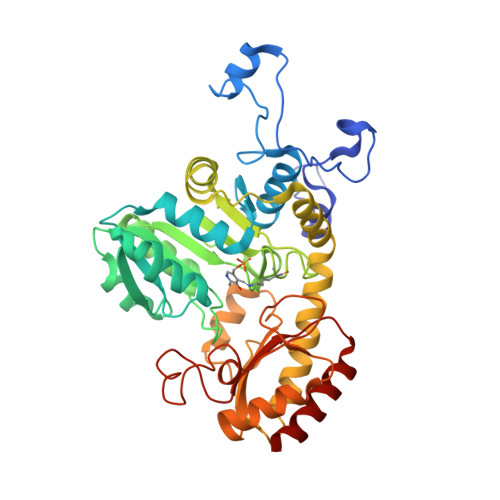The role of amino acid residues in the active site of L-methionine gamma-lyase from Pseudomonas putida.
Fukumoto, M., Kudou, D., Murano, S., Shiba, T., Sato, D., Tamura, T., Harada, S., Inagaki, K.(2012) Biosci Biotechnol Biochem 76: 1275-1284
- PubMed: 22785484
- DOI: https://doi.org/10.1271/bbb.110906
- Primary Citation of Related Structures:
3VK2, 3VK3, 3VK4 - PubMed Abstract:
Cys116, Lys240*, and Asp241* (asterisks indicate residues from the second subunit of the active dimer) at the active site of L-methionine γ-lyase of Pseudomonas putida (MGL_Pp) are highly conserved among heterologous MGLs. In a previous study, we found that substitution of Cys116 for His led to a drastic increase in activity toward L-cysteine and a decrease in that toward L-methionine. In this study, we examined some properties of the C116H mutant by kinetic analysis and 3D structural analysis. We assumed that substitution of Cys116 for His broke the original hydrogen-bond network and that this induced a significant effect of Tyr114 as a general acid catalyst, possibly due to the narrow space in the active site. The C116H mutant acquired a novel β-elimination activity and lead a drastic conformation change in the histidine residue at position 116 by binding the substrate, suggesting that this His residue affects the reaction specificity of C116H. Furthermore, we suggest that Lys240* is important for substrate recognition and structural stability and that Asp241* is also involved in substrate specificity in the elimination reaction. Based on this, we suggest that the hydrogen-bond network among Cys116, Lys240*, and Asp241* contributes to substrate specificity that is, to L-methionine recognition at the active site in MGL_Pp.
- Graduate School of Natural Science and Technology, Okayama University, Okayama, Japan. kinagaki@cc.okayama-u.ac.jp
Organizational Affiliation:


















